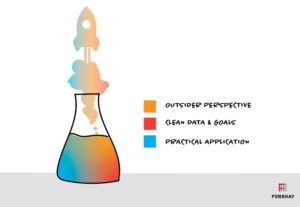Why Every [Excellent] Leader Is a Behavioral Scientist

Often, leaders come to us looking for THE answer in their continual quest to improve inclusion and diversity. Yet, my years of research and experience in the inclusion and diversity space have taught me that the answers aren’t really all that important. Instead, truly excellent leaders are able to tap into the power of asking the right questions.
How do we find the right questions? The first step is to think of yourself as a behavioral and social scientist, focused on individual human behaviors, and the social contexts surrounding them.
With this mindset in hand, we become data gatherers and experimenters. We commit to continually analyzing the data and tweaking our experiments so we can learn, both from our own trials and the best research being done today. We take measurable actions based on informed insights so we don’t unconsciously step into the vast array of biases, and, ultimately, into a bad decision.
Here are three questions to consider when thinking about your own inclusion and diversity programs:
1) It’s what you do with the science that matters.
The term “psychological safety” became big after Google did their own study on why some teams were higher performing than others (no surprise: it had nothing to do with where the employee went to college). Harvard’s Dr. Amy Edmondson pioneered this research in 1999, but the way Google applied and replicated the science moved the needle on team performance across the company.
How are you applying the science in practical ways that improve team performance?
2) Know what you don’t know.
We’ve all seen teams who (despite good intentions) are simply guessing as to where to spend their time and budget. What are realistic inclusion and diversity goals for your team? What is a stretch goal, and how much work does that require to deliver? By gathering local and national labor market data, creating a clear timeline, and using a framework of evidence-based strategies, you can create diversity representation goals that are both achievable and grounded. To succeed, we have to start with clear data, and then build targeted interventions to have the highest impact.
Do you have the data you need to create achievable goals?
3) Co-create and dump assumptions.
The addition of a new perspective to a team’s already diverse backgrounds and life experiences will enhance the empathy and creative output of the project, not to mention save time. If you have all the same players on yet another project, we humbly suggest including a fresh viewpoint. As one fancy-brand client of ours bluntly put it: “It’s not that we think your consultants are all smarter [than our employees], but by being outsiders you all question things we have grown accustomed to.” (Author’s note: I am from Minnesota and believe my clients and consultants are all above average.)
How are you using new viewpoints to accelerate ideas and actions?
When we ask questions like a behavioral scientist, we can improve team performance by creating and meeting achievable goals. Which is key. Because when it comes to complex problems we won’t arrive at the perfect solution, we’ll experiment into better ways of working, one good question at a time.






